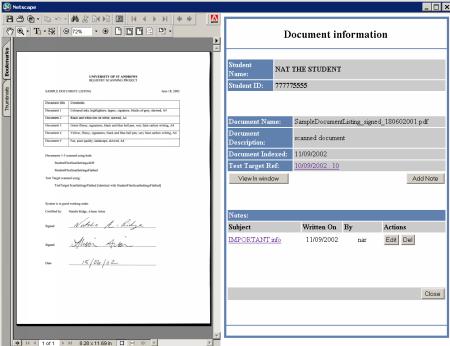Python Success Stories

The University of St Andrews, founded in 1411, is Scotland's oldest university Zoom in
Introduction
The IT Services department at the University of St Andrews, Scotland, develops and maintains software systems used in a variety of capacities throughout the university.
I had several years of experience working with Perl when I took my first serious look at Python back in 1999. Our team's projects were becoming bigger and more complex, and it was obvious that we needed to bring to them more structure and clarity. I had been looking at Java for some time, but its potential benefits seemed to come at the cost of a steep learning curve, and an overall increase in development time. In contrast, Python appeared to offer the prospect of having both clarity and productivity at the same time. And if we ever needed to make use of Java's class libraries there was always Jython, an implementation of Python for the JVM. The increasing number of Python books being published testified to the language's growing popularity, and the number of available libraries was beginning to rival Perl's. This convinced me to give Python a try.
Python Finds a Home
Soon thereafter, I introduced Python to my fellow developers in the IT Services department at the University of St Andrews, Scotland. It is now the mainstay of our software development efforts.
Python has been used successfully by IT Services for a number of projects. These have included systems administration scripts, where it is used alongside Perl and shell scripts, and also sizeable enterprise systems deployed across the university.
By using it on a number of projects, we have come to understand that Python's dynamic nature, support for high-level data structures, and easy object-orientation all lower the barrier to writing well-structured reusable code in less time. The language's clear and simple syntax helps to reveal the sense (or otherwise!) of our code. This makes it easier to understand and reason about code during development and - more critically - during later maintenance. The fact that Python is so easy to learn has been quite useful as well.
Job Vacancies Facility
One of our earliest Python projects was a facility for University job vacancies. This was implemented using Zope, an innovative Python-based web application server that provides a range of web components plus powerful facilities for templating and integration. I started the project with a colleague who had more experience in web design than programming. After some time, we found that Python's powerful simplicity enabled my colleague to improve his programming skills rapidly, to the point where he was able to continue development of the system by himself. Zope itself also helped in this regard, by reducing the amount of programming that needed to be done in the first place.
Student Record System

Document-management system for student records Zoom in
One of our larger projects was a system for managing student records. It employs a model-view-controller architecture in order to promote reuse. Presentation is handled by Cheetah, an open-source templating technology for Python. The interface between Python and the underlying Oracle database is handled by the high-quality DCOracle2 driver made freely available by Zope Corporation.
Matching Students with Classes
Python was also used for a web-based system that managed the process of matching students with the classes they wish to take in the coming year. The system was used by most of our students and a number of our staff for various stages of the process - from selecting preferences in the spring and summer, through to final validation during matriculation at the start of the new academic year. The system implemented work-flow and notification mechanisms.
Because of the number of concurrent users that the system was expected to support, particularly during matriculation, we felt that a traditional CGI approach could lead to performance problems. Instead, we employed mod_scgi, an Apache module that implements the client end of the SCGI protocol for long-running web processes (similar to FastCGI). The server end of the SCGI protocol was implemented by Quixote, a Python-based web framework. Quixote also provided a URL mapping mechanism that simplified the job of publishing objects on the web. Cheetah was again used for handling presentation, and Oracle was used for storage.
We were assigned this project somewhat late in the process, and it was clear that it would come into active use while parts of it were still being developed. To support this, we planned to deliver the system in stages, but we were aware from the outset that many of the system requirements still had to be discovered and understood. We knew this would lead us to rewrite parts of the system as we went along and worked to obviate this with design decisions aimed at decoupling the system's components. Python's dynamic nature and supreme flexibility made it easier to write generic interfaces, which later facilitated the rewriting and refactoring tasks we had to undertake.
Conclusion
Since switching to Python, we are writing better structured and more readable code in less time ... and it's fun! I can't think of a better testament to a programming tool.
About the Author
Hamish Lawson is a software developer in the IT Services department at the University of St Andrews, Scotland. He specializes in web-based information systems.
